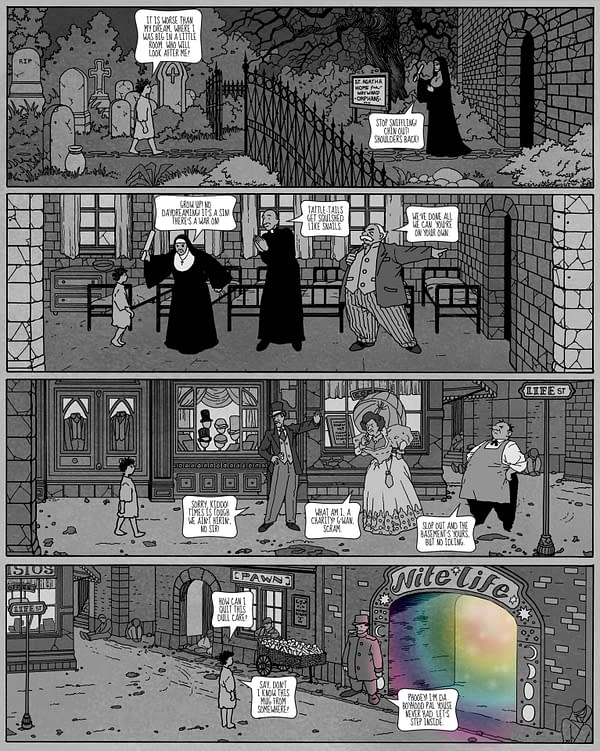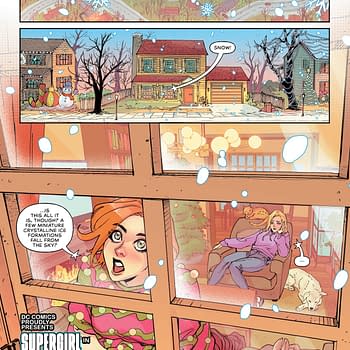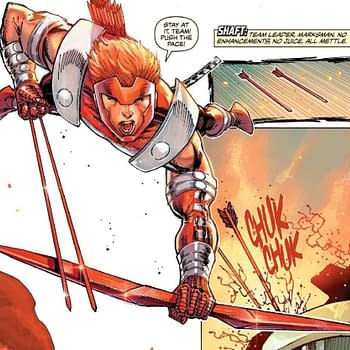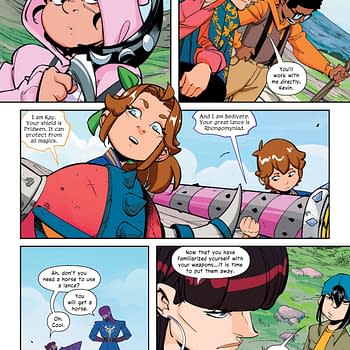Posted in: Comics, Recent Updates | Tagged: Alan Moore, Comics, electricomics, entertainment, john reppion, leah moore, Little Nemo, NESTA, Peter Hogan, winsor mccay
Alan Moore Endorses 'Different Types Of Storytelling' Over 'Enhancement' In Electricomics

When Electricomics launched on September 2nd, it brought with it "Big Nemo", by Alan Moore and Colleen Doran, "Sway", by Leah Moore, John Reppion, and Nicola Scott, "Cabaret Amygdala" by Peter Hogan and Paul Davidson , and "Red Horse" by Garth Ennis and Frank Victoria. Each of the comics hailing from a different genre, also utilized different features possible for comics storytelling on the new platform, and are meant to suggest potential areas for developing new comics features among app users. With just enough time to download the app and have a gander at Alan Moore and Colleen Doran's "Big Nemo", I then spoke to Moore on the very day of the app's launch.

Alan Moore: Yes, so I hear. I was told by Leah that it would be today and Pete Hogan phoned me up to congratulate earlier this morning. Me and Pete being from a slightly different era, neither of us possesses tablets. So we were congratulating each other on the fact that after all these years of work, the project has actually materialized. Then we were wondering if "materialize" is quite the right word. I've seen earlier stages of Electricomics. Have you had the chance to see it yet, Hannah?
HMS: I have! I have downloaded the app to my tablet, and I have had the chance to read Big Nemo. I have yet to read the others since that was just a few minutes ago. But it's beautiful.
AM: Oh, thank you. From my position of complete ignorance, I wanted to try to think of some of the likely pitfalls of this type of comic book, or whatever it actually is. I wanted then to think of my solutions to those completely self-invented problems. I had no way of knowing this for sure, but I hoped that somehow we would have advanced the thinking about storytelling a little bit, to bring it up to speed with the actual advances in technology. I'm really glad that you found it at least interesting, Hannah, at least what you've seen of it so far.

AM: Good. I can say that, particularly, I had no idea what I was doing. This was why my wisest decision was getting Leah involved so early. Since she and John [Reppion] had worked on The Thrill Electric, which I think was their first approach to digital comics, which they did online with Channel 4 a couple of years ago…
HMS: Right.
AM: So, Leah is the person at the absolute center of the entire project. It really would not have happened without her. She's held it together every step of the way. Often at considerable personal stress, when you imagine her with gigantic twins climbing all over her. When we originally kicked off the idea, it was as I may have said before, a completely hypothetical idea for a film prop.
HMS: Yes, I was going to ask you if there was still any relationship in place between the idea for Electricomics in the film and the reality you've launched today [at the time of speaking].
AM: There certainly is. Right back from the beginning, when we were doing the first five films, we'd thought about this possible feature film, which I've now written the screenplay for, and that proceeds at the usual pace of such things, meaning we don't know when, if ever, it will finally start to appear. We wanted to create everything in it. The magazines, the newspapers, the television programs, the soft drinks, the clothing, the music—everything was actually created, slightly satirically. So that every element of this imagined society was there. This included a socially problematic computer game, and it included a scene where one of the characters is walking across a hospital car park and there are kids sitting upon a wall, reading a comic.
My initial thinking was probably that if I was going to be involving myself with film then I wanted to actually think it through as thoroughly as I could. And I was also thinking that any films these days have to be realized upon multiple platforms, that people will be expecting you to do a computer game, a graphic novel, all of these things—and I really don't like that. I was thinking, is there a way we could do all that, but more creatively?
So, I decided that, rather than doing a computer game that was about The Show and Jimmy's End, we would do a computer game that was actually a feature of the world in Jimmy's End, and it would, in some ways, be part of the plot. Then we would design this computer game, and at some point, we would export it into the real world. Rather than doing a graphic novel of the show, I thought it would be more interesting to come up with a different form of comic book that people read in this world, and then export it into reality. I thought, "This is setting up an interesting principle". The idea of creating things within a completely imaginary environment, then making them real.
So, back to the car park and the children sitting on the wall reading a comic, they were reading something from an unusual device, which I called a "spindle". This was like a tube, maybe a foot long, from which a flexible screen could be pulled down, giving you a huge image area. And on the screen, the kids were reading a different kind of comic. I suggested that they were reading "Big Nemo".

AM: Yes. So I was thinking, "They are reading some kind of digital motion comic. What would be the best way to do one of them?" I suppose my thinking was that, in terms of kinetic movement within a still comic book page, we have never bested Winsor McCay. As an animator, as one of the fathers of modern animation, McCay was ingeniously using the comics page to give a really visceral sense of movement, growth, and change of shape. He was taking a lot of elements that Georges Melies had been using in cinema slightly prior to that point. So I was thinking that McCay's techniques would adapt very interestingly to this new medium. In this scene, the kids are reading the comic, and there is movement on the page, and perhaps some sound track. This is stuff you'd only glimpse for a few seconds, a background detail to only one scene.
We then started to get people approaching us about actually making some of these things in real life. At one point we had an energy drink manufacturer talking to us about actually producing our imaginary energy drink. Then at one point, Mitch [Jenkins] had been talking to various people, and our producer Pete Coogan had been talking to people, and it turned out that the government organization NESTA, an innovations charity, had a certain amount of money to give to the favored proposal for something which would use a new technology in an interesting way. And we put in our bid for Electricomics. Largely through Leah going down there and making the pitch, and the fact that it was a good idea, we got awarded the money which was the start of this project. Then we actually had to think of how we were going to realize that.

The idea of a war story sounded interesting, and at the time, in 2014, it was exactly the 100 year anniversary of the First World War. We suggested to Garth Ennis that he might want to set his story during the First World War. And he turned in "Red Horse". Garth's approach was, "I'm just going to write the story and you do what you want with it". Having gotten Garth's story, we saw that actually there wasn't much we wanted to do to it. It was a nice little story, paced so well, so we decided we wanted that one to simply scroll down. That was all we were going to do to it. We thought about sound and animation for it, but there was no actual need. That is one of the ways you can enjoy comics in that form. And all of the other writers came up with different ideas. I thought it was a really interesting mix.
From Pete Hogan's "Cabaret Amygdala", which is a really interesting, modern horror story, with an interesting manner of unfolding.
Leah and John have done "Sway", which I believe, as with a couple of Leah's stories, had its origin in a dream. She had this fragmentary dream where all she could remember of it was that there was some kind of drug called "sway" and if you leaned forward, you'd be leaning into the future…
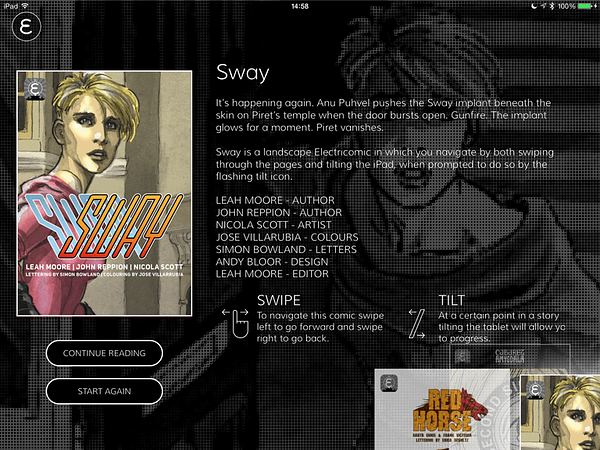
AM:…and if you leaned backward, you would be leaning into the past.
She said it was a really interesting little dream, though it didn't totally make sense. She began to think, "What if we could actually connect that up with swaying the screen?"
HMS: Yes. I remember hearing about that feature at the Electricomics panel at Thought Bubble.
AM: She thought that maybe it could trigger something. So she and John built the story up around that.
With "Big Nemo", the whole pitch is basically within the two word title. I was thinking, "What would have happened to Little Nemo if he had grown up? Would he still have the same relationship with dreams? The America around him, how would that have changed?" Of course, if he had grown up at any kind of realistic rate, he would have grown up into a Depression.
I'm a huge fan of McCay and Little Nemo, in particular. I've probably been toying with pastiches of it since I was a teenager. I thought that actually, with this new technology, there were possibilities. Not to outdo McCay, because I don't think that anybody ever will. The fact that he was doing this with paper and ink alone puts us to shame. But that said, there were opportunities. I was thinking, "How would McCay have used this if he was alive?" These elements of movement which are very subdued animation. Because the last thing you'd want these comics to be is unsuccessful animation.
AM: It's a very fine line. If you give them too much "enhancement", they are on the verge of being a low-rent animated film and that's not what you want. You have to really think through the processes that you're using. I was trying to use each of the pages in mine to feature a different type of storytelling. I'm very pleased with the result. I think that, although it's kind of depressing, it does look delightful.
[*Note: This is Part One of a series of interviews with Alan Moore about Electricomics. Stay tuned for further installments on Bleeding Cool!]
You can learn more about NESTA and the digital arts fund by following them on Twitter @nesta_uk or the hashtag #artsdigital

Find the Electricomics app here. Find the Electricomics website here. Find the team on Twitter here.
Credits:
All photographs are copyright Mitch Jenkins/Orphans Of The Storm
Screengrabs are copyright Orphans Of The Storm
All art copyright Orphans Of The Storm
Sway is written by Leah Moore and John Reppion, art by Nicola Scott, with colours by Jose Villarrubia and letters by Simon Bowland
Big Nemo is written by Alan Moore with art by Colleen Doran, colours by Jose Villarrubia and letters by Erica Schultz
Red horse is written by Garth Ennis with Art and colours by Frank Victoria and letters by Erica Schultz
Cabaret Amygdala Presents: Second Sight is written by Peter Hogan, art by Paul Davidson, colours by Jose Villarrubia and letters by Simon Bowland
All animation and enhancement of the art in the app was done by Ocasta, namely Giulia Alfonsi, with assistance from Sean Gannon
Art prep and colour flatting is by Andy Bloor and Craig Scheuer
The cover image is by Colleen Doran and coloured by Jose Villarrubia
All Logo Designs are by Todd Klein


